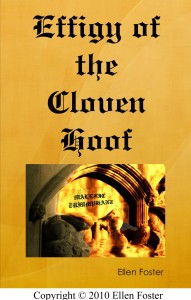Effigy of the Cloven Hoof
Synopsis
The opening pages of this historical mystery novel carry the reader into the midst of a demonic storm raging one night in Gloucestershire, England on the banks of the Severn River in the early autumn of the year 1400. It is a time of widespread unrest and rampant suspicion in England. Henry Bolingbroke has usurped the throne and recently the news of the death of the deposed King Richard II in Pontefract Castle has spread abroad in the land.
As elemental furies lash the manor of the Lady Apollonia of Aust, we meet the Lady and are introduced to the inner circle of her affinity: Nan Tanner, her personal maid, Giles Digby, the household steward, Friar Francis, her chaplain and Brother William, her almoner. Unknown to the Lady’s household a tidal bore has surged up the Severn Estuary leaving in its wake a pre-dawn tide of dead lepers, forced by their outcast status to always remain beyond contact of any human community. Lady Apollonia grants her protection to the surviving lepers and personally directs the collection and burial of their dead. One savagely decapitated body found in a tidal pool on her lands is discovered to be not a dead leper but an old adversary of the Lady, Sir Wilfrid de Guelf, liege man to her first husband, who possibly maintains an ancient grudge against her.
Manipulating the ambitions of the Abbot of nearby Kingswood Abbey, Lady Apollonia positions herself in sanctuary there, remaining at the center of the search for information. While she stays at the Abbey, her forester, Alwan, locates the dismembered head of the victim. But the frightening circumstances of Sir Wilfrid’s death and menacing occurrences within her own household drive the Lady to pursue a personal quest for answers.
We meet the Lady’s elder brother Ferdinand, who recalls the strange events surrounding his sister’s birth and her dedication at birth to Saint Apollonia, the patron saint of those who suffer toothache. We are introduced to her first husband, Sir Geoffrey Montecute, a hero of Poitiers, garter knight and debauchee, a vicious bestial blossom of the flower of Chivalry. Lady Apollonia’s second marriage to Edward Aust, a wealthy franklin, within a month of her first husband’s death is revealed as a long and happy union of twenty-seven years blessed with five sons, each named for a saint native to the British Isles: Chad, Hugh, Thomas, Alban and David. Her third husband is an old family friend and wealthy merchant of Corsham whose death after a brief marriage leaves her in possession of substantial wealth from three husbands: lands, farms and business interests. The Lady protects her wealth and preserves the independence of her latter years by taking a vow of chastity approved by the Bishop of Worcester and her brother, Ferdinand as head of her family.
We learn how each member of the Lady’s household entered her service and now wears the lady’s cognizance of a red heart surrounded by a vine of English ivy; how Nan, Giles, Francis, William, Alwan, Owen, Guise the Norman Cook, Gareth the stable master, and Mad Mag the brew-mistress add their stories to the Lady’s careful creation of her personal affinity, devoted and loyal to her above any other.
Lady Apollonia visits the widow of Sir Wilfrid de Guelf in Cliffbarton House overlooking Porlock Bay in Somerset. She learns of Sir Wilfrid’s locally feared family reputation as worshipers of the devil and visits the derelict manor church where his ancestor’s tomb effigy proclaims “MALEFIC TRIUMPHANT” She also learns that Sir Wilfrid was being pursued by three foreign knights just prior to his death who, she believes, were owed something by him. Sending two young Welshmen of her household, Owen her page and Alwan the Forester, into Wales to spy on the foreign knights, the scene shifts to Chepstow Castle. Only the eldest of the foreign knights is discovered remaining in the kingdom, the younger two having returned to their homeland and he, the Bohemian knight, is followed by the Lady’s young henchmen as he leaves Wales and returns to Aust.
Lord Casimir of Prague at last reveals himself to Apollonia as nephew of the Holy Roman Emperor, Wenceslaus, and brother to one of the ladies in waiting to Princess Anne of Bohemia, first Queen Consort of King Richard II.
